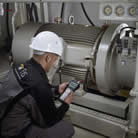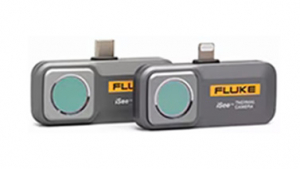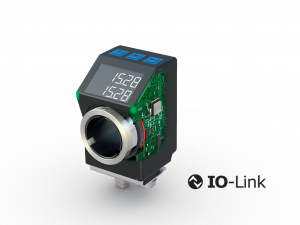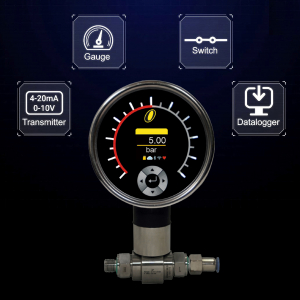Condition monitoring system with RFID technology ensures users collect the right data every time

The Schaeffler Group’s FAG Detector III handheld vibration and temperature monitoring and balancing device is now available with RFID technology, enabling automatic identification of measuring points on plant machinery and equipment, while eliminating operator errors and resulting in a more efficient data collection process.
The maintenance management and condition monitoring division of Schaeffler UK, FAG Industrial Services (F’IS), is now offering customers RFID technology for its FAG Detector III device, the company’s handheld vibration monitoring and balancing system. The RFID technology ensures that all measuring points on a route plan or routine maintenance check through a plant, are automatically identified and that the data from these measuring points is then recorded in the correct place for further analyses.
As with fixed, online monitoring systems, measurements with handheld, offline devices must be made regularly and at exactly the same measuring points as before. Only in this situation can meaningful data be obtained and analysed to predict potential equipment failure.
But even the most experienced maintenance engineers can make mistakes when using mobile vibration monitoring systems. User prompts and easy-to-use software are designed to keep these mistakes to a minimum, but manual errors do still occur, which can cost companies dearly.
Imagine a maintenance engineer who is walking around a factory on a routine maintenance check, who needs to collect condition monitoring data from 100 different measuring points. That engineer could, by accident, select an incorrect measuring point on the handheld device’s display and, in effect, collect the data from the wrong machine or pump. The consequences of this could be catastrophic, especially if the measuring point is on a critical piece of production machinery within that plant.
As Ian Pledger, F’IS Field Service Engineer at Schaeffler UK points out: “If the engineer incorrectly selects even one measuring point during his routine maintenance check around the plant, and then feeds this data into the maintenance management database, the spurious data may distort his trend analyses. An alarm that is triggered by false data may lead him to strip down the wrong machine. The real fault is left undetected on another machine which potentially could break down, causing a double headache for the company.”
The new FAG Detector III with RFID technology is designed to eliminate user errors such as these. The RFID tags are simply fastened to the machine or equipment, as close to the measuring point as possible. When the maintenance engineer next does his or her routine checks, the RFID reader, built into the FAG Detector III, correctly identifies each of the tags in the plant. This system ensures that the user collects repeatable, reliable data from the correct measuring points, which can then be stored appropriately in a maintenance management database and then analysed further.
Pledger explains further: “Basically, the RFID technology ensures that operator error is eliminated. It gives the user an automatic, 100 per cent guaranteed cross-reference check between what he thinks he is measuring, to what he should actually be measuring on his route plan. Up to now, companies have had to rely on the maintenance engineer to record the collected data in the right place, which is where mistakes can happen.”
“With condition monitoring, repeatability of measurements on any piece of machinery or equipment is paramount. Otherwise, you run the risk of collecting spurious data, analysing this false data and then mis-diagnosing a machine fault,” he adds.
Unveiled at the recent Hanover Fair exhibition in Germany, the new technology is ideal for maintenance teams that regularly collect and analyse vibration monitoring data from multiple, similar measuring points – on machine tools, pumps, bearings, electric motors, fans, compressors, ventilators, gearboxes and spindles.
Unlike conventional barcodes, the RFID tags can operate at temperatures up to 120°C and are resistant to dirt, oil and acids. Existing tags within a plant that operate in the right frequency range (13.56Mhz, ISO 15693) can also be read by the FAG Detector III unit.
FAG Detector III is used for the early detection of damage in rotating machine elements such as rolling bearings. The device is the latest addition to Schaeffler’s ‘Detector’ series of damage diagnosis instruments. The device is available with an optional, extended operational balancing function. The customer can activate this function at a later stage after purchasing the basic unit. The device can be used to balance rotors and shafts in both static and dynamic balancing applications.
The Detector III includes the full range of accessories required to carry out a balancing process, including sensors, trigger, magnetic holder and reflection marks.
There’s also an integrated, step-by-step user dialogue, which allows inexperienced operators to record and analyse reliable, accurate balancing data. The device can be operated with one hand using 21 keys and the keyboard itself is resistant to dust and spray water. There’s also a headset jack so that users can assess acoustic emissions from plant and machinery.
As well as retaining some of the familiar characteristics of the popular Detector series, the Detector III also has a number of new, improved features. In addition to completely redeveloped, 16-bit hardware, the new device has increased storage space, storage of up to 300 time signals and a new reporting function. It also incorporates a second measurement channel for operational balancing, a new expanded keyboard and a viewer for displaying signals.
The built-in software, ‘FAG Trendline’ – which includes a database of more than 20,000 different bearing products from different suppliers – enables the user to analyse measurement data recorded using the FAG Detector III. Used in combination with the data viewer, the bearing database is ideal for assessing a machine’s condition. For example, up to four different measurement values can be stored and displayed against one measurement point and several defect bearing frequencies can be checked efficiently using a single measurement point.
Users also get an expanded, configurable ‘report generator’, which can be used to prepare a wide range of reports. Reports can be stored as templates and tailored for different customers. All the information in the system can be used for the report, including time signals, trend curves and alarm data.
Downloads
Similar articles
More from Schaeffler AG
- Schaeffler accelerates transformation 31st July 2017
- Dietmar Heinrich takes CEO reins at Schaeffler 18th July 2017
- Companies develop strategic steel cooperation 31st March 2017
- Schaeffler expands into electric mobility 21st December 2016












Write a comment
No comments